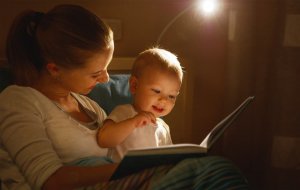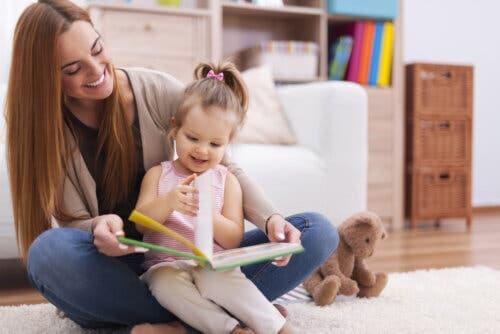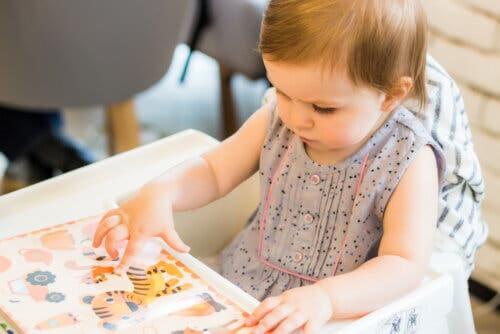Sound Books for Babies and Small Children

Sound books are a fantastic way to stimulate cognitive and emotional development in babies and children, as well as attract their attention. Below we’ll tell you a little bit more about sound books and also provide a selection.
Many years ago, children’s literature made its way into classrooms, allowing small children to discover books. From birth, and even until they began to read, books weren’t a part of children’s lives because what could they do with them, as they had no letters?
However, the concept of children’s literature has changed and evolved towards other branches, in which illustrations have become the undisputed stars of stories.
For the smallest audience, specifically babies and small children between the ages of 0 and 2, and who aren’t yet able to understand the illustrations, other branches have made literature attract their attention.
Everything you need to know about sound books
Babies don’t have the ability or autonomy to pick up a book and explore it on their own. However, if the adults around babies show them these books and incorporate them as a routine into their daily lives, as they grow up, they’ll read on a daily basis.

The great impact children’s literature has on them has made it expand. Thus, nowadays, you can find books for all ages and about all kinds of subjects. Babies aren’t the exception. Thus, there are books for babies and small children as well.
Today, we want to focus on the books that most attract the attention of children: musical or sound books.
Why do sound books attract children’s attention?
Since babies are in their mother’s belly, they begin to feel and hear everything that happens around them. This is why they have a highly developed sense of hearing from birth. Therefore, any type of sound stimulates them and attracts their attention.
Babies particularly like sounds from animals or certain vehicles, such as from police cars or ambulances.
In this regard, animals are the main characters of the vast majority of sound books. The associations children begin to make between illustrations and sounds are also beneficial for their cognitive development. Below, you’ll find a selection of sound books that we’re sure your baby or toddler will love!
Sound books for babies and small children
Zoo Sounds by Sam Taplin
There are different types of sound books for children, depending on their age. As we mentioned above, books about animals with their respective sounds appeal to babies.
In this case, this one, written by Sam Taplin, is the perfect way to help them start learning about animals and the sounds they make. More specifically, this story presents five animals: an elephant, a penguin, a monkey, a seal, and a lion.

Associated with each of the illustrations, which are big and with few details so that children begin to familiarize themselves with them, you’ll find the characteristic sound of each one of them.
Potty Time! by Scarlett Wing
This book will be a great help for the little ones who are starting potty training. In addition, we’re sure they’ll have a lot of fun with it, thanks to its sounds!
With the help of Daniel, the main character of the story who’s approximately the same age as the children who read the book, they’ll understand all the necessary potty training processes.
In addition, it contains fun illustrations and sounds, including toilet flushing sounds and handwashing sounds. Also, the book includes a fun song that will help your little ones in this new adventure.
Poppy and the Orchestra: With 16 musical instrument sounds! by Magali Le Huche
The main characters of this fantastic book are animals that teach the little ones up to 16 new musical instruments, such as the xylophone, flute, or violin. It’s the perfect book that allows children to discover all the instruments while they have fun and enjoy their illustrations and sounds.
Sound books are a fantastic way to stimulate cognitive and emotional development in babies and children, as well as attract their attention. Below we’ll tell you a little bit more about sound books and also provide a selection.
Many years ago, children’s literature made its way into classrooms, allowing small children to discover books. From birth, and even until they began to read, books weren’t a part of children’s lives because what could they do with them, as they had no letters?
However, the concept of children’s literature has changed and evolved towards other branches, in which illustrations have become the undisputed stars of stories.
For the smallest audience, specifically babies and small children between the ages of 0 and 2, and who aren’t yet able to understand the illustrations, other branches have made literature attract their attention.
Everything you need to know about sound books
Babies don’t have the ability or autonomy to pick up a book and explore it on their own. However, if the adults around babies show them these books and incorporate them as a routine into their daily lives, as they grow up, they’ll read on a daily basis.

The great impact children’s literature has on them has made it expand. Thus, nowadays, you can find books for all ages and about all kinds of subjects. Babies aren’t the exception. Thus, there are books for babies and small children as well.
Today, we want to focus on the books that most attract the attention of children: musical or sound books.
Why do sound books attract children’s attention?
Since babies are in their mother’s belly, they begin to feel and hear everything that happens around them. This is why they have a highly developed sense of hearing from birth. Therefore, any type of sound stimulates them and attracts their attention.
Babies particularly like sounds from animals or certain vehicles, such as from police cars or ambulances.
In this regard, animals are the main characters of the vast majority of sound books. The associations children begin to make between illustrations and sounds are also beneficial for their cognitive development. Below, you’ll find a selection of sound books that we’re sure your baby or toddler will love!
Sound books for babies and small children
Zoo Sounds by Sam Taplin
There are different types of sound books for children, depending on their age. As we mentioned above, books about animals with their respective sounds appeal to babies.
In this case, this one, written by Sam Taplin, is the perfect way to help them start learning about animals and the sounds they make. More specifically, this story presents five animals: an elephant, a penguin, a monkey, a seal, and a lion.

Associated with each of the illustrations, which are big and with few details so that children begin to familiarize themselves with them, you’ll find the characteristic sound of each one of them.
Potty Time! by Scarlett Wing
This book will be a great help for the little ones who are starting potty training. In addition, we’re sure they’ll have a lot of fun with it, thanks to its sounds!
With the help of Daniel, the main character of the story who’s approximately the same age as the children who read the book, they’ll understand all the necessary potty training processes.
In addition, it contains fun illustrations and sounds, including toilet flushing sounds and handwashing sounds. Also, the book includes a fun song that will help your little ones in this new adventure.
Poppy and the Orchestra: With 16 musical instrument sounds! by Magali Le Huche
The main characters of this fantastic book are animals that teach the little ones up to 16 new musical instruments, such as the xylophone, flute, or violin. It’s the perfect book that allows children to discover all the instruments while they have fun and enjoy their illustrations and sounds.
All cited sources were thoroughly reviewed by our team to ensure their quality, reliability, currency, and validity. The bibliography of this article was considered reliable and of academic or scientific accuracy.
- Celis Méndez, S. M. (2020). El audiolibro como estrategia pedagógica para nuevas lecturas y nuevos lectores, revisión del estado del arte. https://repository.usta.edu.co/bitstream/handle/11634/31706/2020sandracelis.pdf?sequence=6&isAllowed=y
- Le huche, M. (2017). Paco y la orquesta. Timunmas.
- Suasti, G. A. M., & Mieles, J. E. C. (2021). Recursos digitales para fomentar la animación lectora en los estudiantes de la básica elemental: Español. Revista Científica Sinapsis, 2(20).
- Taplin, S. (2018). Mi primer libro de sonidos: el zoo. Usborne.
- Vargas Castro, K. V. (2021). Las tecnologías informáticas (cuentos interactivos) y su incidencia en el desarrollo de la memorización. Dilemas contemporáneos: educación, política y valores, 8 (SPE3). https://www.scielo.org.mx/scielo.php?pid=S2007-78902021000500004&script=sci_arttext
- Vvaa. (2018). Voy sola al baño. Timunmas.
This text is provided for informational purposes only and does not replace consultation with a professional. If in doubt, consult your specialist.








